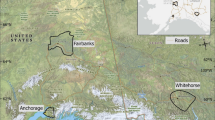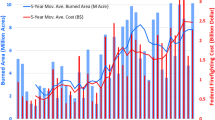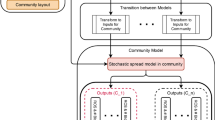Abstract
The majority of wildfires in Spain are caused by human activities. However, much wildfire research has focused on the biological and physical aspects of wildfire, with comparatively less attention given to the importance of socio-economic factors. With recent changes in human activity and settlement patterns in many parts of Spain, potentially contributing to the increases in wildfire occurrence recently observed, the need to consider human activity in models of wildfire risk for this region are apparent. Here we use a method from Bayesian statistics, the weights of evidence (WofE) model, to examine the causal factors of wildfires in the south west of the Madrid region for two differently defined wildfire seasons. We also produce predictive maps of wildfire risk. Our results show that spatial patterns of wildfire ignition are strongly associated with human access to the natural landscape, with proximity to urban areas and roads found to be the most important causal factors We suggest these characteristics and recent socio-economic trends in Spain may be producing landscapes and wildfire ignition risk characteristics that are increasingly similar to Mediterranean regions with historically stronger economies, such as California, where the urban-wildland interface is large and recreation in forested areas is high. We also find that the WofE model is useful for estimating future wildfire risk. We suggest the methods presented here will be useful to optimize time, human resources and fire management funds in areas where urbanization is increasing the urban-forest interface and where human activity is an important cause of wildfire ignition.



Similar content being viewed by others
References
Agterberg FP, Bonham-Carter GF, Wright DF (1990) Statistical pattern integration for mineral exploration. In: Gaal G, Merriam DF (eds) Computer applications in resource estimation. Pergamon Press, Oxford, pp 1–21
Aspinall R (1992) An inductive modelling procedure based on Bayes’ theorem for analysis of pattern in spatial data. Int J GIS 6:105–121
Aspinall R, Veitch N (1993) Habitat mapping from satellite imagery and wildlife survey data using a Bayesian modeling procedure in a GIS. Photogramm Eng Remote Sens 59:537–543
Badia-Perpinyà A, Pallares-Barbera M (2006) Spatial distribution of ignitions in Mediterranean periurban and rural areas: the case of Catalonia. Int J Wildland Fire 15:187–196
Bonham-Carter GF (1994) Geographic information systems for geoscientists, modelling with GIS. Pergamon, Tarrytwon, New York
Bonham-Carter GF, Agterberg FP, Wright DF (1989) Weights of evidence modelling: a new approach to mapping mineral potential. In: Agterberg FP, Bonham-Carter GF (eds) Statistical applications in the earth science. Geological Survey of Canada, pp 171–183
Bonham-Carter GF, Agterberg FP (1999) Arc-WofE: a GIS tool for statistical integration of mineral exploration datasets. The 52 Session of the International Statistical Institute. Bulletin of the International Statistical Institute, Helsinki, Finland, p 4
Boyce MS, Vernier PR, Nielsen SE, Schmiegelow FKA (2002) Evaluating resource selection functions. Ecol Modell 157:281–300
Butry DT, Mercer DE, Prestemon JR, Pye JM, Holmes TP (2001) What is the price of catastrophic wildfire?. J Forestry 99:9–17
Cardille JA, Ventura SJ, Turner MG (2001) Environmental and social factors influencing wildfires in the upper Midwest, United States. Ecol Appl 11:111–127
Carranza EJM, Hale M (2000) Geologically Constrained probabilistic mapping of gold potential, Baguio District, Philippines. Nat Resour Res 9:237–253
Carranza EJM, Hale M (2002) Where are porphyry copper deposits spatially localized? A case study in Benguet Province, Philippines. Nat Resour Res 11:45–59
Chou YH, Minnich RA, Salazar LA, Power JD, Dezzani RJ (1990) Spatial autocorrelation of wildfire distribution in the Idyllwild Quadrangle, San Jacinto Mountain, California. Photogramm Eng Remote Sens 56:1507–1513
Chou YH, Minnich RA, Chase RA (1993) Mapping Probability of fire occurrence in San Jacinto Mountains, California, USA. Environ Manage 17:129–140
Chuvieco E, Congalton RG (1989) Application of remote-sensing and GIS to forest fire hazard mapping. Remote Sens Environ 29:147–159
Chuvieco E, Salas J (1996) Mapping the spatial distribution of forest fire danger using GIS. Int J Geogr Inf Syst 10:333–345
D. G. del Medio Natural (1997) Mapa de Vegetación y Ocupación del Suelo. Consejería de Medio Ambiente y Ordenación del Territorio. Comunidad de Madrid, Madrid
D. G. del Medio Natural (2000) Áreas Recreativas (Cartografía). Consejería de Medio Ambiente y Ordenación del Territorio. Comunidad de Madrid, Madrid
de Vasconcelos MJP, Silva S, Tome M, Alvim M, Pereira JMC (2001) Spatial prediction of fire ignition probabilities: comparing logistic regression and neural networks. Photogramm Eng Remote Sens 67:73–81
Dickson BG, Prather JW, Xu YG, Hampton HM, Aumack EN, Sisk TD (2006) Mapping the probability of large fire occurrence in northern Arizona, USA. Landsc Ecol 21:747–761
Elith J, Graham CH, Anderson RP, Dudik M, Ferrier S, Guisan A, Hijmans RJ, Huettmann F, Leathwick JR, Lehmann A, Li J, Lohmann LG, Loiselle BA, Manion G, Moritz C, Nakamura M, Nakazawa Y, Overton JM, Peterson AT, Phillips SJ, Richardson K, Scachetti-Pereira R, Schapire RE, Soberon J, Williams S, Wisz MS, Zimmermann NE (2006) Novel methods improve prediction of species’ distributions from occurrence data. Ecography 29:129–151
Fielding AH, Bell JF (1997) A review of methods for the assessment of prediction errors in conservation presence/absence models. Environ Conserv 24:38–49
Guisan A, Zimmermann NE (2000) Predictive habitat distribution models in ecology. Ecol Modell 135:147–186
Hirzel AH, Le Lay G, Helfer V, Randin C, Guisan A (2006) Evaluating the ability of habitat suitability models to predict species presences. Ecol Modell 199:142–152
Hooten MB, Larsen DR, Wikle CK (2003) Predicting the spatial distribution of ground flora on large domains using a hierarchical Bayesian model. Landsc Ecol 18:487–502
INE (1999) Censo Agrario. Instituto Nacional de Estadística, Madrid
INE (2001) Censo de Población y Vivienda. Instituto Nacional de Estadística, Madrid
Kemp LD, Bonham-Carter GF, Raines GL (1999) WofE: Arcview extension for weights of evidence mapping. http://www.ntserv.gis.nrcan.gc.ca/wofe
Kemp LD, Bonham-Carter GF, Raines GL, Looney CG (2001) Arc-SDM: arcview extension for spatial data modelling using weights of evidence, logistic regression, fuzzy logic and neuronal networks analysis. http://www.ntserv.gis.nrcan.gc.ca/sdm/.
Mercer DE, Prestemon JP (2005) Comparing production function models for wildfire risk analysis in the wildland-urban interface. Forest Policy Econ 7:782–795
Milne BT, Johnston KM, Forman RTT (1989) Scale-dependent proximity of wildlife habitat in a spatially-neutral Bayesian model. Landsc Ecol 2:101–110
Millington JDA (2005) Wildfire risk mapping: considering environmental change in space and time. J Mediterr Ecol 6:33–42
MMA (2007) Los incendios forestales en España. Decenio 1996–2005. Área de Defensa Contra Incendios Forestales. Ministerio de Medio Ambiente, Madrid, p 106
Moreno JM, Vázquez A, Vélez R (1998) Recent history of forest fires in Spain. In: Moreno JM (ed) Large forest fires. Backhuys, Leiden, pp 159–185
Pearce JL, Boyce MS (2006) Modelling distribution and abundance with presence-only data. J Appl Ecol 43:405–412
Perry GLW, Millington JDA (2007) Spatial modelling of succession-disturbance dynamics in terrestrial ecological systems. Perspect Plant Ecol Evol Systematics doi:10.1016/j.ppees.2007.07.001
Prestemon JP, Pye JM, Butry DT, Holmes TP, Mercer DE (2002) Understanding broadscale wildfire risks in a human-dominated landscape. For Sci 48:685–693
Romero-Calcerrada R, Perry GLW (2002) Landscape change pattern (1984–1999) and implications for fire incidence in the SPA Encinares del rio Alberche y Cofio (Central Spain). In: Viegas DX (ed) Forest fire research & wildland fire safety. Millpress, Rotterdam
Romero-Calcerrada R, Perry GLW (2004) The role of land abandonment in landscape dynamics in the SPA ‘Encinares del rio Alberche y Cofio, Central Spain, 1984–1999. Landsc Urban Plan 66:217–232
Romero-Calcerrada R, Luque S (2006) Habitat quality assessment using weights-of-evidence based GIS modelling: the case of Picoides tridactylus as species indicator of the biodiversity value of the Finnish forest. Ecol Modell 196:62–76
SCR (2000) Mapa Topográfico. Consejería de Obras Públicas, Urbanismo y Transportes. D. G. de Planificación Territorial. Comunidad de Madrid, Madrid
Skidmore AK (1989) An expert system classifies eucalypt forest types using Thematic Mapper data and a digital terrain model. Photogramm Eng Remote Sens 55:1449–1464
Syphard AD, Clarke KC, Franklin J (2007a) Simulating fire frequency and urban growth in southern California coastal shrublands, USA. Landsc Ecol 22:431–445
Syphard AD, Radeloff VC, Keely JE, Hawbaker RJ, Clayton MK, Stewart SI, Hammer RB (2007b) Human influence on California Fire Regimes. Ecol Appl 17:1388–1402
Tucker K, Rushton SP, Sanderson RA, Martin EB, Blaiklock J (1997) Modelling bird distributions—a combined GIS and Bayesian rule-based approach. Landsc Ecol 12:77–93
Vázquez A, Moreno JA (1995) Patterns of fire occurrence across a climate gradient and it’s relationship to meteorological variables in Spain. In: Moreno JA, Oechel WC (eds) Global change and Mediterranean-type ecosystems. Springer Verlag, New York, pp 408–434
Venevsky S, Thonicke K, Sitch S, Cramer W (2002) Simulating fire regimes in human-dominated ecosystems: Iberian Peninsula case study. Glob Chang Biol 8:984–998
WWF/Adena (2004) Incendios Forestales. Causas, situación actual y propuestas. WWF/Adena, Madrid, p 25
WWF/Adena (2005) Incendios Forestales. ¿Porqué se queman los bosques españoles? WWF/Adena, Madrid, p 49
Yang J, Healy HS, Shifley SR, Gustafson EJ (2007) Spatial patterns of modern period human-caused fire occurrence in the Missouri Ozark Highlands. For Sci 53:1–15
Acknowledgements
We thank the two anonymous reviewers for the extremely valuable comments provided as well as the editorial comments. We would like to express our gratitude to Servicio de Cartografía Regional and Sección de Defensa Contra Incendios Forestales of the Regional Government of Madrid for the Digital cartography and Ignition Point database. We also wish to thank at the Ministry of Education and Sciences for the finance received (project CGL2004-06049-C04-02/CLI., FIREMAP).
Author information
Authors and Affiliations
Corresponding author
Rights and permissions
About this article
Cite this article
Romero-Calcerrada, R., Novillo, C.J., Millington, J.D.A. et al. GIS analysis of spatial patterns of human-caused wildfire ignition risk in the SW of Madrid (Central Spain). Landscape Ecol 23, 341–354 (2008). https://doi.org/10.1007/s10980-008-9190-2
Received:
Accepted:
Published:
Issue Date:
DOI: https://doi.org/10.1007/s10980-008-9190-2




